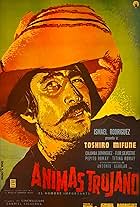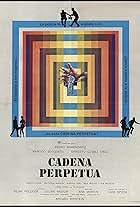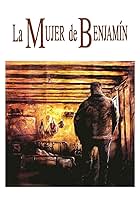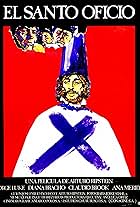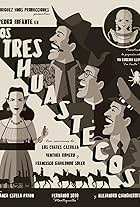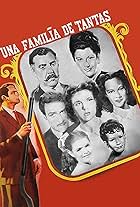A group of semi-slave laborers rebel against the appalling work conditions in a logging camp deep in the Mexican jungle.A group of semi-slave laborers rebel against the appalling work conditions in a logging camp deep in the Mexican jungle.A group of semi-slave laborers rebel against the appalling work conditions in a logging camp deep in the Mexican jungle.
- Awards
- 4 wins & 3 nominations
Ariadne Welter
- Modesta
- (as Ariadne)
Princesa Maya Nicte-Há
- Esposa de Cándido
- (as Princesa Nicte-ha)
Storyline
Did you know
- ConnectionsRemade as La rebelión de los colgados (1986)
- SoundtracksGavotte
(uncredited)
Music by François-Joseph Gossec
Played on the phonograph when Acacio is brought back to camp
Featured review
B. Traven's novels have sold 25 million copies in thirty languages. He himself is an obscure, shadowy figure and by all accounts he went out of his way to remain so. There is not even a birth certificate and it has even been suggested that he was the illegitimate son of Kaiser Wilhelm.
What IS certain is that 'he had Mexico in his bones' and the sharp-eyed will recognise his name on the credits as the author of 'Treasure of the Sierra Madre'. His cycle of 'Mahogany' novels of which 'Rebellion of the hanged' is the fifth' also reveal him to be a fervent socialist intent on showing the appalling, slave-like conditions suffered by Mexican Indians in the mahogany logging camps during the rule of dictator Porfirio Díaz.
The film's poster declares 'Love! Lust! Violence!' There is not a great deal of love on display here it must be said but there is a modicum of lust supplied by the ravishing Amanda del Llano. There is certainly plenty of violence in the form of the cruelty dispensed by the two monstrous labour agents who are played with relish by Carlos López Moctezuma and Luis Aceves Castaneda. Their ultimate fates at the hands of their victims represent the punishment fitting the crime.
It is directed by Alfredo B. Crevenna and Emilio Fernández who is uncredited. Where one leaves off and the other begins is uncertain but one cannot fail to see the influence of the mighty Fernández here in terms of characterisation, dramatic tension and a tendency to 'overcook' it. Atmospheric cinematography and powereful score are supplied by his regular collaborators Gabriel Figuroa and Antonio Díaz Conde. Certainly no stranger to Fernández is Pedro Armendáriz who is immensely sympathetic as a Tzotzil Indian. Unusual to see Víctor Junco dressed as a peon rather than in his customary lounge suit.
Although a Silver Ariel was awarded to editor Gloria Schoemann one feels that there may have been some 'censorial' editing here. The material is as brutal as cinema at the time would have permitted and packs quite a punch as both film and social document.
B. Traven said that 'an author should have no other biography than his books'. In his case that is all we are ever likely to have.
What IS certain is that 'he had Mexico in his bones' and the sharp-eyed will recognise his name on the credits as the author of 'Treasure of the Sierra Madre'. His cycle of 'Mahogany' novels of which 'Rebellion of the hanged' is the fifth' also reveal him to be a fervent socialist intent on showing the appalling, slave-like conditions suffered by Mexican Indians in the mahogany logging camps during the rule of dictator Porfirio Díaz.
The film's poster declares 'Love! Lust! Violence!' There is not a great deal of love on display here it must be said but there is a modicum of lust supplied by the ravishing Amanda del Llano. There is certainly plenty of violence in the form of the cruelty dispensed by the two monstrous labour agents who are played with relish by Carlos López Moctezuma and Luis Aceves Castaneda. Their ultimate fates at the hands of their victims represent the punishment fitting the crime.
It is directed by Alfredo B. Crevenna and Emilio Fernández who is uncredited. Where one leaves off and the other begins is uncertain but one cannot fail to see the influence of the mighty Fernández here in terms of characterisation, dramatic tension and a tendency to 'overcook' it. Atmospheric cinematography and powereful score are supplied by his regular collaborators Gabriel Figuroa and Antonio Díaz Conde. Certainly no stranger to Fernández is Pedro Armendáriz who is immensely sympathetic as a Tzotzil Indian. Unusual to see Víctor Junco dressed as a peon rather than in his customary lounge suit.
Although a Silver Ariel was awarded to editor Gloria Schoemann one feels that there may have been some 'censorial' editing here. The material is as brutal as cinema at the time would have permitted and packs quite a punch as both film and social document.
B. Traven said that 'an author should have no other biography than his books'. In his case that is all we are ever likely to have.
- brogmiller
- Sep 15, 2021
- Permalink
Details
- Release date
- Country of origin
- Language
- Also known as
- Pobuna obešenih
- Filming locations
- Chiapas, Yucatan, Mexico(exterior scenes)
- Production company
- See more company credits at IMDbPro
- Runtime1 hour 25 minutes
- Color
- Aspect ratio
- 1.37 : 1
Contribute to this page
Suggest an edit or add missing content

Top Gap
By what name was La rebelión de los colgados (1954) officially released in Canada in English?
Answer















